Learning stations are a dynamic and practical strategy for implementing personalized learning in classrooms. By dividing instruction into targeted activities, learning stations allow students to engage with content in varied ways, at their own pace, and according to their learning preferences. This flexible, student-centered approach helps educators address diverse needs while promoting independence and deeper understanding.
What Are Learning Stations?
Learning stations are designated areas in the classroom where students work on different tasks or explore specific concepts. Each station focuses on a unique aspect of a lesson, such as skill-building, collaboration, hands-on exploration, or independent practice. Students rotate through the stations individually or in small groups, which helps maintain engagement and create a rhythm for learning.
How Learning Stations Support Personalized Learning
- Targeted Instruction
- Teachers can group students by skill level or learning style and assign tasks that meet their specific needs.
- Some stations may provide remediation, while others offer enrichment or challenge opportunities.
- Student Choice and Autonomy
- Offering choice in which stations to complete or in what order promotes self-direction and ownership.
- Students can engage with content in formats that best suit their interests—such as reading, technology, or hands-on activities.
- Flexible Pacing
- Students spend more time on stations where they need extra support and move quickly through concepts they’ve already mastered.
- Blended Learning Opportunities
- Technology-enhanced stations provide interactive, adaptive tools that adjust to each student’s progress.
- Digital resources can be combined with traditional activities for a balanced, personalized experience.
Examples of Learning Station Types
- Teacher-Led Station: Small-group instruction focused on direct teaching or guided practice.
- Tech Station: Use of digital tools, apps, or online games for independent practice and feedback.
- Collaborative Station: Partner or group activities for discussion, problem-solving, or projects.
- Hands-On Station: Experiments, models, or manipulatives to reinforce concepts kinesthetically.
- Reading or Writing Station: Tasks involving texts, prompts, or journaling tailored to current learning goals.
Tips for Effective Implementation
- Start with 3–4 stations and expand gradually.
- Set clear instructions and expectations at each station.
- Use timers and visual cues to manage rotation smoothly.
- Collect data or reflections at each station to inform future planning.
- Include a “choice station” or optional activities to enhance personalization.
Conclusion
Learning stations are a powerful way to bring personalized learning to life. By offering variety, flexibility, and structure, they help meet the diverse needs of students while promoting active engagement and self-directed learning. With thoughtful design and consistent practice, learning stations can transform classrooms into dynamic spaces where all learners can thrive.













